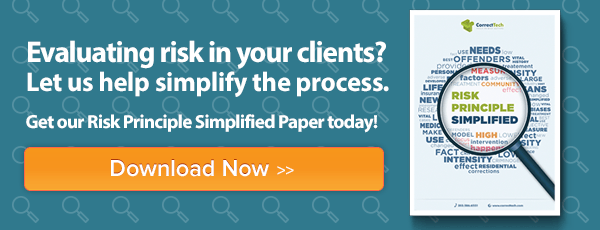This is the 2nd of a 7 part series on The Risk Principle Simplified. Subscribe to our blog and get the series delivered right to your inbox.
Why Does it Need to be Objective?

“Objective” means not influenced by personal feelings, interpretations, or prejudice; based on facts; unbiased. Prior to the use of objective measures of risk, subjective assessment was used. Subjective assessment of risk is based on a review of the clients’ history and a verbal interview with the individual about their plans and attitudes. In other words, subjective assessment is based on instinct or “gut” and therefore more reflective of the evaluator’s biases and/or the likeability of, or the effective manipulation by, the offender. Objective assessment accomplishes two things:
- Appropriate Focus: In order to measure the likelihood of criminal behavior, we must focus on the criteria that actually led to crime. Risk assessment is helpful only if you are measuring the presence and/or absence of characteristics that actually correlate with criminal behavior. For example, since research has proven that low self-esteem does not predict crime, focusing on it is not helpful.
-
Decreased Bias: Objective measurement takes the evaluator’s biases out of the equation. Regardless of our education, training or experience, all of us have social and/ or cognitive biases outside of our awareness. For example, “in-group bias” is the tendency for people to give preferential treatment to others they perceive to be members of their own groups. With dozens of cognitive biases in action at all times, your brain makes decision making a real challenge. In general, evaluator’s instinct, in the absence of an objective risk instrument, results in an overestimation of risk.
The first widely accepted objective risk measurement was the Level of Supervision Inventory (LSI). Originally developed by Don Andrews and James Bonta and revised in 2003, the LSI is used worldwide as an objective measure of risk. It consists of 54 items grouped in 10 psychological, sociological, and legal elements based on the recidivism literature. Currently, there are a variety of risk assessment products, including many in the public domain. The choice of an objective risk assessment should be preceded by a literature review of the various instruments to determine which one best fits the needs and structure of a given community. In fact, several states have decided to develop their own risk assessment instrument.
A Lesson from the Insurance Industry:
If you’ve ever purchased a life insurance policy, you’ve participated in a risk assessment process. When you apply for a life insurance policy, the insurance company attempts to determine how likely you are to die before the age of 70. In order to predict that “risk,” they look at a variety of factors that make you higher risk for a premature death.
Some of these factors are completely out of your control. Male gender, childhood medical issues, and family history each contribute to risk and these factors cannot be changed. Risk factors that cannot be changed are known as static risk factors. No matter what you do, you can’t change your family history.
Fortunately, some factors that contribute to risk for early death can be changed. High risk behaviors (behaviors that are more likely to lead to an early death, thus a large life insurance pay out) include sky diving, motorcycle riding, smoking, and heavy alcohol use. If you stop smoking, your risk of early death will decrease (and therefore your life insurance premium would go down). Risk factors that can be changed are known as dynamic risk factors. In the correctional literature, dynamic risk factors are also referred to “criminogenic needs”.
The goal of offender intervention is to decrease risk. Since static risk factors cannot be changed, interventions are focused on factors that increase risk but can be changed. Once these needs are identified, the goal becomes how to best intervene.
In our next blog in this series, we will address "Now What?". Subscribe to our blog and get the series delivered right to your inbox.



